This article is being considered for deletion in accordance with Wikipedia's deletion policy. Please share your thoughts on the matter at this article's deletion discussion page. |
These flowers come into bloom in late Spring season:
This article is being considered for deletion in accordance with Wikipedia's deletion policy. Please share your thoughts on the matter at this article's deletion discussion page. |
These flowers come into bloom in late Spring season:
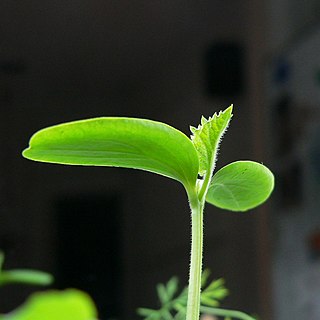
In botany, a plant shoot consists of any plant stem together with its appendages, leaves and lateral buds, flowering stems, and flower buds. The new growth from seed germination that grows upward is a shoot where leaves will develop. In the spring, perennial plant shoots are the new growth that grows from the ground in herbaceous plants or the new stem or flower growth that grows on woody plants.

Hydrangea common names hydrangea or hortensia, is a genus of over 75 species of flowering plants native to Asia and the Americas. By far the greatest species diversity is in eastern Asia, notably China, Korea, and Japan. Most are shrubs 1–3 m tall, but some are small trees, and others lianas reaching up to 30 m (100 ft) by climbing up trees. They can be either deciduous or evergreen, though the widely cultivated temperate species are all deciduous.

Anemone is a genus of flowering plants in the buttercup family Ranunculaceae. Plants of the genus are commonly called windflowers. They are native to the temperate and subtropical regions of all continents except Australia, New Zealand and Antarctica. The genus is closely related to several other genera including Anemonoides, Anemonastrum, Hepatica, and Pulsatilla. Some botanists include these genera within Anemone.

Hyacinthoides non-scripta is a bulbous perennial plant, found in Atlantic areas from north-western Spain to the British Isles, and also frequently used as a garden plant. It is known in English as the common bluebell or simply bluebell, a name which is used in Scotland to refer to the harebell, Campanula rotundifolia. In spring, H. non-scripta produces a nodding, one-sided inflorescence of 5–12 tubular, sweet-scented violet–blue flowers, with strongly recurved tepals, and 3–6 long, linear, basal leaves.

Forsythia, is a genus of flowering plants in the olive family Oleaceae. There are about 11 species, mostly native to eastern Asia, but one native to southeastern Europe. Forsythia – also one of the plant's common names – is named after William Forsyth.

Petunia is genus of 20 species of flowering plants of South American origin. The popular flower of the same name derived its epithet from the French, which took the word petun, meaning "tobacco," from a Tupi–Guarani language. A tender perennial, most of the varieties seen in gardens are hybrids.
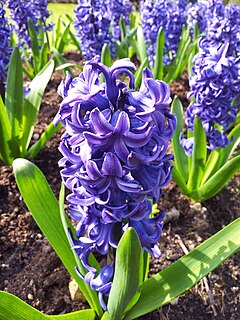
Hyacinthus is a small genus of bulbous, spring-blooming perennials. They are fragrant flowering plants in the family Asparagaceae, subfamily Scilloideae and are commonly called hyacinths. The genus is native to the area of the eastern Mediterranean from the south of Turkey to Palestine, although naturalized more widely.
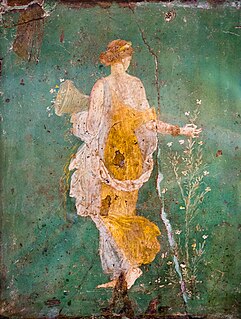
Flora is a Roman goddess of flowers and of the season of spring – a symbol for nature and flowers. While she was otherwise a relatively minor figure in Roman mythology, being one among several fertility goddesses, her association with the spring gave her particular importance at the coming of springtime, as did her role as goddess of youth. She was one of the fifteen deities who had their own flamen, the Floralis, one of the flamines minores. Her Greek counterpart is Chloris.

Commonly known as hellebores, the Eurasian genus Helleborus consists of approximately 20 species of herbaceous or evergreen perennial flowering plants in the family Ranunculaceae, within which it gave its name to the tribe of Helleboreae. Despite names such as "winter rose", "Christmas rose" and "Lenten rose", hellebores are not closely related to the rose family (Rosaceae). Many hellebore species are poisonous.

A pseudanthium is an inflorescence that resembles a flower. The word is sometimes used for other structures that are neither a true flower nor a true inflorescence. Examples of pseudanthia include flower heads, composite flowers, or capitula, which are special types of inflorescences in which anything from a small cluster to hundreds or sometimes thousands of flowers are grouped together to form a single flower-like structure. Pseudanthia take various forms. The real flowers are generally small and often greatly reduced, but the pseudanthium itself can sometimes be quite large.
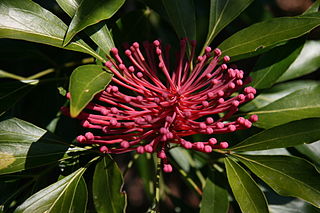
Alloxylon pinnatum, known as Dorrigo waratah, is a tree of the family Proteaceae found in warm-temperate rainforest of south-east Queensland and northern New South Wales in eastern Australia. It has shiny green leaves that are either pinnate (lobed) and up to 30 cm (12 in) long, or lanceolate (spear-shaped) and up to 15 cm (5.9 in) long. The prominent pinkish-red flower heads, known as inflorescences, appear in spring and summer; these are made up of 50 to 140 individual flowers arranged in corymb or raceme. These are followed by rectangular woody seed pods, which bear two rows of winged seeds.
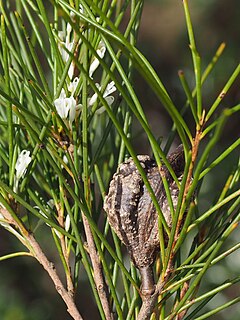
Hakea ochroptera is a species of flowering plant in the family Proteaceae and is endemic to a restricted area of New South Wales. It is a shrub with long, needle-shaped leaves and an abundance of cream-white flowers in spring.

Cenarrhenes is a monytypic genus in the family Proteaceae containing the single species Cenarrhenes nitida, known as the Port Arthur plum or native plum. Cenarrhenes nitida is an evergreen shrub to small tree endemic to the rainforests and scrublands of western Tasmania. It bears white flowers in late spring followed by the development of fleshy fruit.
Persoonia pertinax is a species of flowering plant in the family Proteaceae and is endemic to Western Australia. It is an erect to spreading shrub with hairy young branchlets, twisted linear leaves, and hairy yellow flowers borne in groups of up to ten on a rachis up to 60 mm (2.4 in) long.

Hakea leucoptera, commonly known as silver needlewood, needle hakea, pin bush or water tree and as booldoobah in Koori language, is a shrub or small tree with rigid, cylindrical, sharply pointed leaves and white, cream-coloured or yellow flowers in late spring and early summer. It is widespread and common in central parts of the Australian mainland.
Persoonia tropica is a plant in the family Proteaceae and is endemic to north Queensland. It is an erect shrub to small tree shrub with branchlets that are hairy when young, narrow elliptic to lance-shaped leaves and yellow flowers in groups of three to ten on a rachis 3–10 mm (0.12–0.39 in) long that continues to grow after flowering.

Protea magnifica, commonly known as the queen protea, is a shrub, which belongs to the genus Protea within the family Proteaceae, and which is native to South Africa.
Protea restionifolia, which is also known as the Reed-leaf sugarbush, is a flowering shrub endemic to the Western Cape province of South Africa where it is found from the upper part of the Breede River Valley through the Bot River Valley to Wolseley and the Koue Bokkeveld Mountains.

Monoecy is a sexual system in seed plants where separate male and female cones or flowers are present on the same plant. It is a monomorphic sexual system alongside gynomonoecy, andromonoecy and trimonoecy.

Serruria acrocarpa, the common rootstock spiderhead. is a flower-bearing shrub that belongs to the genus Serruria and forms part of the fynbos. The plant is native to the Western Cape and occurs from the Cederberg to the Southern Cape. The shrub grows to 50 cm in length and flowers in spring.